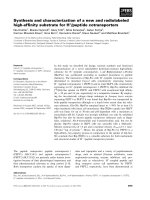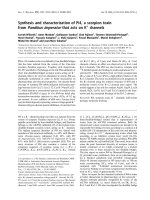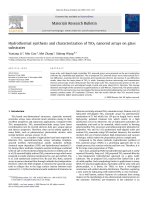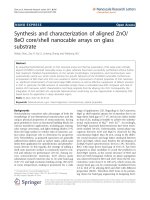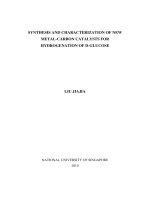STUDY ON SYNTHESIS AND CHARACTERIZATION OF NEW MATERIALS BASED NANOSTRUCTURES OF GRAPHENE APPLIED IN ENVIRONMENTAL TREATMENT
Bạn đang xem bản rút gọn của tài liệu. Xem và tải ngay bản đầy đủ của tài liệu tại đây (1.99 MB, 26 trang )
VIETNAM ACADEMY OF SCIENCE AND TECHNOLOGY
GRADUATE UNIVERSITY SCIENCE AND TECHNOLOGY
……..….***…………
HA QUANG ANH
STUDY ON SYNTHESIS AND CHARACTERIZATION OF NEW
MATERIALS BASED NANOSTRUCTURES OF GRAPHENE
APPLIED IN ENVIRONMENTAL TREATMENT
Major: Theoretical chemistry and physical chemistry
Code: 62.44.01.19
SUMMARY OF CHEMICAL DOCTORAL THESIS
Hanoi – 2016
0
INTRODUCTION
1. The urgency of the thesis
While industry dramatically develops, agriculture also pays the
main role in the expansion of national economy. However, as a
consequence of expanding ecomomy, water resouces are effected by the
toxic agents coming from planting and feeding. These poisons can be
biologicallly deposited in the water, which leads to harm the life of uder
water creatures as well as the human life. Therefore, not only
heightenned the environment protection attitude, Government should
find the way to remove the contaminants (heavy metal ions, dye,
pesticide…) from aqueus solution.
In recent years, carbon materials and the carbon based
materials are widely used as effficient adsorbent because of high
specific surface, stabilization and resistance to chemical and thermal
agent. Moreover, this type of material is easy modified, which leads
to create the new chemical and physical properites such as
decomposating the dye and heavy metal ions. Further more, the
modified material can increase the adsorption capacity and
selectivity for removal of the toxic agents in the waste.
The nano structured carbon materials, such as carbon nano
tubes, are familiar with people. Because of the high cost in
producing, it is limited for the application. So, investigation of new
adsorbents based on carbon material has received a great of interest.
Graphene and Graphene based material are the answers.
Actually, graphene is introduced in 2004 but it received a Nobel
price for this material in 2010. This material is more and more
popular and it is used in the various field: Electronics, photo
electronics, electrical chemistry, mechanics and optics are examples.
1
The graphene is a new carbon material. Basically, it is defined as one
carbon atomic or several carbon layers with sp2 bonding which forms
the crystallization type like honey bee. Thank to their unique
physical and chemical properties, graphene and GO (grapahene
oxide) have many applications, including adsorption area. Although
many studies on synthesis and application ability of graphene based
material are reported. The studies of the modifed graphene still less
focused and investigated. Moreover, the technique which produced
and modifies GO from graphene oxide layer by using microwave and
the reduction from GO to rGO by using thermal reduction still less
reported.
Thus, regarding the reasons mentionned above, we choose the
subject of the thesis: “Study on synthesis and characterization of new
materials based nanostructures of graphene applied in environmental
treatment”
2. Objectives of the thesis
Synthesis and characterization of the GO (exfoliation by using
the microwave (GOVS) and ultrasonic (GOSA) technigues), rGO,
Fe3O4-GO, Fe-Fe3O4-GO and evaluation of these adsorbents for
removal of activated dyes, asenic and heavy metal ions.
3. Main contents of the thesis
- The parameters affect on the GO synthesis by using microwave
and ultrasonication; reduction GO to rGO. Characterizing the
sythesized GO, rGO and Graphite oxide.
- The factors affect on the synthesis Fe3O4-GOVS material such as
pH, concentration ratio Fe3+/Fe2+, temperature and stir speed.
- Synthesi of Fe-Fe3O4-GOVS.
2
- Characterization of Fe3O4-GOVS and Fe-Fe3O4-GOVS by using
XRD, XPS, FTIR, HR-TEM, etc.
- Studying adsorption isotherm, adsorption kinetic of dye and
heavy metal ions by the adsorbents: GOVS, rGO, Fe3O4-GOVS
and Fe-Fe3O4-GOVS.
4. Thesis Layout
The thesis consits of 150 pages, 93 pictures and diagrams, 50
tables and 143 references. In detail:
Preface
Chapter 1: Overview
Chapter 2:: Investigating method and experiment
Chapter 3: Results and Dicussions
Conclusion
List of works has been published
New findings of the thesis
References
Appendix
CHAPTER 1: OVERVIEW
This chapter has 35 pages which briefly introduce the carbon
based material. Moreover, this part also clearly shows the structure
of Graphene, Graphene oxide; adsorptive sites and the graphene,
graphene oxide synthesis methods; preparing magnetic composite
from graphene, graphene oxide and ion oxides. The ability of these
materials in the treatment of dye, asenic and heavy metal ions in
water are included.
3
CHAPTER 2: EXPERIMENT AND INVESTIGATION METHOD
There are 22 pages in this chapter which consist of:
2.1. Experiment
- Synthesis of Graphene oxide by Hummers modified method using
H2SO4 (98%) and KMnO4 as oxidant agents.
- Exfoliation of Graphite oxide by microwave and ultrasonic
technique.
- Synthesizing rGO by thermal reduction method using GO as starting
material in N2 gas flow.
- Synthesizing magnetic composite from Fe3O4 – GO by co-precipitation
method using FeCl3 and FeCl2 as Fe-sources and NH4OH as
precipitation agent.
- Synthesizing Fe-Fe3O4-GO by chemical reduction method by using
NaBH4 as reducing agent
- Eveluation of the adsorption ability of synthesized materials for
RR195, Cd(II), Cu(II) and As(V). Adsorption by Langmuir and
Feundlich model.
- In order to investigate the kinetics of adsorption based on the
pseudo-first-order and pseudo-second-order equations.
2.2. Characterization methods
- Chemical determination composition: EDX, XPS, UV-Vis, AAS.
- Characterizing material method: XRD, TEM, HR-TEM, BET,
FTIR, XPS, FE-SEM, VMS (vibration magnetometer system).
4
CHAPTER 3: RESULTS AND DISCUSSION
This chapter contains 72 pages. The details are:
3.1. The factors affect on the synthesis of GO and rGO
3.1.1. XRD results of Graphite before and after oxidation
The XRD results show that for Graphite-Sigma Aldrich the
peak 2θ = 26,5o is existed, characterizing the Graphite material.
Moreover, the peak 2θ = 11o is the evidence of the oxygen bonding
formation between Graphite layers, which leads to the formation of
GO structure.
3.1.2. The factors affect on the exfoliation of GO by microwave and
ultrasonic technique
* The effect of microwave time: 1,2,3 and 4 minutes
Conditions: microwave power 700 W, graphite oxide weight
1g. Basing on the recovery efficiency and XRD results of all
samples, the suitable microwave time is 2 minutes.
* The effect of microwave power: 216, 700, 1000 and 1200 W
Conditions: graphite oxide weight 1g, microwave time: 2
minutes with different microwave powers. The results of XRD, FTIR
show that the microwave power is 700 W.
* The effect of ultrasonic time on the GOSA process from graphite
oxide: 30, 60 and 120 minutes
On this investigation, the ratio Graphite oxide/H2O at 2 mg/mL,
the graphite oxide weight at 0,1 g and power 40 W are fixed.
According to the XRD and HR-TEM results, the suitable ultrasonic
time is 60 minutes.
5
3.1.4. The effect of temperature on the reduction of GOVS to rGO
The thermal reduction performed at 400, 600, 800 and 1000 oC
with heating rate 20 oC/minute and N2 gas flow 15-20 mL/minute.
Combining with the purpose of saving energy, the results of XRD
and FTIR give 600 oC as the best temperature for reduction. The
yield of this process is in the range of 50 - 60%.
3.2. The characterization of synthesized GO and rGO
3.2.1. X-ray Diffraction methods (XRD)
Cuong do (tuy chon)
Cường độ (a.u)
GOSA
GOVS
10
rGO
20
30
Goc22Theta
thetha(độ)
Góc
40
50
Figure 3.8. XRD Patterns of GOSA, GOVS and rGO after synthesizing
In the XRD patterns of GOVS and GOSA there are characteristic
peaks at 2 = 11,5o and 11,2o, respectively, while for rGO it show a peak
at 2 = 25,8o, which confirm the structure of GO and rGO.
3.2.2. Fourier transform infrared spectroscopy (FTIR)
Figure 3.9. FT-IR spectra of GOSA, GOVS and rGO
6
Thank to these spectroscopies, there is the carbony group –
C=O (in range 1700 -1730 cm-1) in the samples. Beside the carbony
group, there are other groups existed in these samples. C–O in the
range of 1200-1250 cm-1, C=C in aromatic compound in the range of
1500-1600 cm-1 and C-O-C in the range of 1060 cm-1 are examples.
Moreover, beacause of the peak from 3400 – 3850 cm-1, OH group is
existed, which is slightly changed to the range of 3460 – 3500 cm-1
after supersonic process. Moreover, the peak of other groups are also
undergone the change within this process. More detail is C=C at
1633 cm-1, C-O at 1168 cm-1 and carbonyl at 1728 cm-1. It is
interesting that, after thermal reduction, the FTIR result of rGO does
not contain the characterized peaks of GO (fig. 3.9) which
demonstrates the loss of huge amount of the functional group on GO
surface.
3.2.3. High Resolution Transmission Electron Microscope (HR –
TEM)
The calculation from HR-TEM indicates that the number of
layers of GOSA, GOSV and rGO are 10, 7-8 and 5-6, respectively.
Moreover, the gap between each layer is about 0,4 nm for rGO, 0,6 nm.
3.2.4. N2 adsorption–desorption isotherms (BET)
This method determines the specific area, pore size, volume
and the pore distribution of material. The BET results of synthesized
material are in table 3.3.
Table 3.3. The parameters of GOSA, GOVS and rGO
Parameters
GOSA
Specific area (m2/g)
Micro-capillary volume (cm3/g)
Total capillary volume (cm3/g)
Average of capillary diameter (nm)
GOVS
rGO
56
331
300
0,0004
0,0015
0,018
0,283
1,719
1,596
9,6 - 21,4 7,8 - 21,2 8,8 - 22,5
7
From the Table 3.3, the GOVS and rGO have the high specific
area and these are 6 times higher than that of GOSA.
3.2.5. X-ray photoelectron spectroscopy (XPS)
As the results of XPS:
- There are huge amount of oxygen in the functional group existing
on GOSV and GOSA and the number of these group is dramatically
decreased in rGO.
- The thermal reduction from GO to rGO are clearly demonstrated by
the peak of π→π* in the aromatic compound at 291,5 eV.
- On the thermal reduction process from GO to rGO, the ratio of C/O
increases from 2,32 (GOSA) and 2,98 (GOVS) to 6,15 and 10,89,
respectively.
The composition of elements in GOVS, GOSA and rGO is in
table 3.4
Table 3.4. The composition of elements in GOVS, GOSA and rGO (%At)
Sample/elements
C
O
C/O
rGO
GOVS
GOSA
rGO (from thermal
reduction GOSA)
91,59
73,92
69,88
7,41
25,08
30,12
10,89
2,98
2,32
86,02
13,98
6,15
3.3. The factors effect on the Fe3O4-GOVS synthesizing
In this part, we focus on synthesizing and evaluating the properties
of Fe3O4-GOVS synthesized by co-participation method. By this way, the
products have the small particle size, fine distribution and easy to recover
by the external magnetic field.
3.3.1. The effect of co-participation reaction temperature
For clearly showing the effect of co-participation reaction
temperature on the morphology, phase change and size of Fe3O4GOVS Nano, the samples are made under the various temperature: 30
o
C (GF1), 50 oC (GF2) and 80 oC (GF3). The characterized methods
are used: XRD, XPS and TEM. While the XRD shows the increase of
8
particle size Fe3O4 nano on GOVS with increasing temperature, XPS
results demonstrate that there is only Fe3O4 on GOVS (without γFe2O3). Therefore, in the reaction temperature range from 30 to 80 oC,
the synthesized materials are purity (only phase Fe3O4 on GOVS).
TEMs of GF1, GF2 and GF3 give the shape of Fe3O4 on GOVS. This
shape is spherical and it is fine distribution, especially the sample at 80
o
C. The particle size of GF1, GF2 and GF3 has the increasing trend
with 8 nm for GF1, 13 nm for GF2 and 15 nm for GF3. The XPS also
conclude that the sample with 80 oC acheives the highest Fe
concentraion (17,23%). In brielfly, 80 oC is chosen.
3.3.2. The effect of precursor concentration
Making samples with the different concentration ratios Fe3+/Fe2+:
N (0,01M/0,005M), GF3 (0,1M/0,05M), N1 (1M/0,5M) và N2
(2M/1M), with the reaction temperature at 80 oC, pH = 10 and stir
speed 500 rpm.
The particle size increases with the rise of concentration ratio,
basing on the XRD results. The particle size is determined with
Scheerer equation which is collected in Table 3.7
Tabke 3.7. Paticle size of Fe3O4-GOVS synthesizing
Sample
N
GF3
N1
N2
dXRD (nm)
7,3
13,4
18,2
36,1
When comparing the TEM results of all sample, we see that it
easily distinguishes the change in particle size. For example, the
particle size in N, GF3, N1 and N2 is 8 nm, 15 nm, 25 nm and 40 nm,
respectively. Moreover, Fe3O4 is in the spherical shape, fine
distribution and posited at the space between each layer. However, for
high recovery efficiency, we need the high saturated sample. Two
sample GF3 and N1 belong to the highest group. So, the choice is GF3.
9
3.3.3. The effect of pH
For studying, we make the samples with the different pH: pH
= 8 (GF4), pH =10 (GF3), pH = 12 (GF5), and the reaction
temperature is 80 oC, Fe3+/Fe2+ concentration ratio = 0,1M/0,05M, stir
speed 500 rpm.
The shape and size of particle are observed under FE-SEM
spectroscopy. Figure 3.21 is the FE-SEM spectroscopies of three
Fe3O4-GOVS samples under different pH.
(a)
(b)
(c)
Figure 3.21. FE-SEM images of Fe3O4-GOVS under different pH
GF3(a), GF4(b) và GF5(c)
Fig. 3.21 shows the particle size of each sample. For pH = 8
(GF4), the particle size is about 20 nm. In comparison, sample with pH
= 10 (GF3) is about 15 nm and 18 nm is the particle size of sample pH
= 12 (GF5). The particle size increases with the increase of pH. So, we
choose the pH = 10.
3.3.4. The effect of stir speed
The samples are made with the stir speed: 200 (V1), 350 (V2),
500 (GF3) and 1000 rpm (V4), pH = 10, reaction temperature 80 oC,
Fe3+/Fe2+ concentration ratio= 0,1M/0,05M.
According to the XRD results, if the stir speed increases, the
particle size decrease. For example, the particle size of samples V1,
V2, GF3 and V4 are 24,1 nm; 14,08 nm; 13,4 nm và 12,7 nm,
respectively. Moreover, this conclusion is tightened by the TEM
results which give the average particle size of sample V1, V2, GF3
and V4. Those are 30 nm, 20 nm, 15 nm and14 nm. Furthermore, for
10
the range 500-1000 rpm, there is a slight decrease in particle size.
Therefore, we choose the stir speed 500 rpm.
3.4. Synthesizing Fe3O4-GOVS and Fe-Fe3O4-GOVS material
- Procedure for synthesizing Fe3O4-GOVS
Figure 3.24. The procedue for synthesizing Fe3O4 - GOVS
Basing on the above results, after geting Fe3O4-GOVS, we will
make the Feo nano on this surface by using NaBH4 as a reducer agent
and Fe3+ from (FeCl3.6H2O). The nitrogen is blown on this system
(fig. 2.5). By this method, the percentage of Feo on Fe3O4-GOVS
surface is about 10% in weight.
Figure 2.5. Procedure for synthesizing Fe-Fe3O4-GOVS
11
3.5. Characterization of Fe3O4-GOVS and Fe-Fe3O4-GOVS
3.5.1. X-ray diffraction (XRD)
Intensity (a.u)
M
*
440
M
422
400
M
511
220
M
311
*: Feo
111
M: Fe3 O4
M
M M
*
Fe3O4-GO
Fe-Fe3O4-GO
10
20
30
40
50
60
70
2 Thetha Scale
Figure 3.25. XRD patterns of Fe3O4-GOVS and Fe-Fe3O4-GOVS
XRD results show that there are the formation of Fe0 and
Fe3O4 on the samples, which is the cause of existing the peaks 2θ at
45° and 68°. These peaks are characterized for Feo.
3.5.2. TEM and HR-TEM Spectroscopy
(a)
(b)
(c)
Figure 3.26. The TEM of Fe3O4-GOVS (a) and Fe-Fe3O4-GOVS (b,c)
12
As the results of TEM and HR-TEM Spectroscopy (Figure 3.26),
the particle size of Fe3O4 nano is about 12-17 nm. However, there are
some clusters of Fe3O4 having the particle size with 20 nm. In contrasting,
the particle size of Feo nano is slightly small (about 5-10 mm).
3.5.3. FTIR Spectroscopy
Intensity (a.u)
According to FTIR
results, there is Fe3O4
nano on the surface of
GOSV, which leads to
the existance of peak at
578,2 cm-1. This is the
characterized peak for
Fe-O bonding in Fe3O4,
Fe-Fe3O4 and GOVS.
While the peaks at 1230
Wavenumber (cm )
cm-1 and 1576 cm-1 are
C=O and C-O, the peak
Figure 3.27. FTIR spectra of Fe-Fe3O4-GO
at 2342 cm-1 are the
and Fe3O4-GO
bonding of CO2 with
Fe3O4-GOVS and Fe-Fe3O4-GOVS. Furthermore, there is the
formation of Feo nano on the Fe3O4-GOVS because of the
characterized peak at 1048,5cm-1.
-1
3.5.4. EDX Spectroscopy of Fe-Fe3O4-GOVS and Fe3O4-GOVS
EDX Spectroscopy results in Table 3.8.
Table 3.8. The element composition in Fe3O4-GOVS and
Fe-Fe3O4-GOVS
Fe3O4-GOVS
Fe-Fe3O4-GOVS
Element
% weight
% atom
% weight
% atom
C
35,97
74,46
29,96
57,98
O
15,44
19,98
12,36
17,97
Fe
48,59
17,96
57,68
24,05
Total (%)
100
100
100
100
13
From Table 3.8, the percentage of Fe in Fe3O4-GOVS is about
48,59% in weight and 18% in atom, which is close to the initial
calculation ( 50% in weight and 20 % in atom). After adding to Feo
with 10% in weight on the Fe3O4-GOVS, the percentage of Fe in
weight reaches to 57,68% (~ 9.1% in weight). It is close to the initial
calculation.
3.5.5. N2 adsorption–desorption isotherms (BET) of Fe-Fe3O4-GOVS
and Fe3O4-GOVS
The BET results show that these materials belong to the layer
structure form. From Table 3.9, Fe-Fe3O4-GO has a high specific area
and high pore volumn and these are higher than that of Fe3O4-GOVS.
Moreover, these two material belongs to average capillary system
(average capillary system is 99%, while the micro capillary system is
about 1%). The capillary diameter is in the range from 8-13 nm.
Table 3.9. Textual characteristics of Fe-Fe3O4-GOVS and Fe3O4-GOVS
Parameters
Fe3O4-GOVS
Fe-Fe3O4-GOVS
169
177
Micro-capillary volume (cm3/g)
0,0033
0,0043
Total capillary volume (cm3/g)
0,499
0,523
Average of capillary diameter (nm)
8,8 - 12,1
8,9 - 12,3
Specific area (m2/g)
3.5.6. XPS spectra of Fe-Fe3O4-GOVS and Fe3O4-GOVS
XPS spectroscopy results (Fig 3.30) demonstrate the purity of
Fe3O4 on the GO because there are the characterized peaks at 711 eV
and 725 eV. For Fe-Fe3O4-GOVS, beside the peaks of Fe3O4, two other
peaks at 719 and 733 eV are existed. It can be explained by the reaction
between Feo and Fe3O4-GOVS, which is conduct to the formation of
Fe2O3, FeOOH. Moreover, because of the peak at 706 eV, the particle
size of Feo nano is predicted about less than 10 nm. Although these XPS
14
spectroscopies do not contain the peaks of -Fe2O3, the: C-C, C-O, OC=O, C=O, Fe-O and π-π* are still remained.
Fe 2p1/2 725 eV
Fe2p3/2 711 eV
Fe3+ 733eV
Intensyty (a.u)
Intensity (a.u)
C1s
Fe- Fe3O4-GO
O1s
Fe2p
Na1s
Fe3 O4 -GO
Fe0 706 eV
740
1300
1100
Fe3+ 719 eV
Fe-Fe3 O4 -GO
Fe3O4-GO
900
700
500
300
735
730
725
720
715
710
705
700
Binding Energy (eV)
100
Binding Energy (E)
C-C 284.8 eV
C-O 535 eV
Intensity (a.u)
Intensity (a.u)
Fe-O 529.9 eV
C=O 531.5 eV
-C=O 288.3 eV
C-O 285.5 eV
291.5 ev
540
538
536
534
532
530
528
296
526
294
292
290
288
286
284
282
280
Binding Energy (eV)
Binding Energy (eV)
Figure 3.30. XPS spectra of Fe-Fe3O4-GOVS and Fe3O4-GOVS
3.5.7. Magnetic property of Fe-Fe3O4-GOVS and Fe3O4-GOVS
Using VSM to study the magnetic property of these sample,
the results show that the coercive force is close to zore for both two
samples. Moreover, the staturated magnetization of Fe3O4-GOVS is
35 emu/g. Similarly, that value of Fe-Fe3O4-GOVS is 29 emu/g.
3.6. Adsorption ability of GOSA, GOVS and rGO material
The next part is the adsoprtion ability of GOSA, GOVS and
rGO material for the die RR195. For Fe3O4-GOVS and Fe-Fe3O4GOVS, beside RR195, we also investigate the adsorption ability for
some metallic ions such as: Cu(II), Cd(II) and As(V).
15
3.6.1. The adsorption ability of GOVS, GOSA and rGO for RR195
3.6.1.1. The effect of pH
The effect of pH
on
the
adsoprtion
capacity
of
these
materials for RR195 is
illustrated in picture
3.32. Basing on this
picture, the effect of pH
on adsoprtion ability of
rGO is not so much. On
the other hand, the
Figure 3.32. The effect of pH on the
higher pH is, the lower
adsorption
of GO and rGO for RR195
adsorption capacity of
GOVS and GOSA are.
The pH = 5.5 is chosen because of the real application.
3.6.1.2. Estimating the adsorption ability of GOVS, GOSA and rGO for
RR195
The experiment is carried out with the below conditions:
temperature fixed at 30 oC, pH fixed at 5.5, stir speed fixed at 150
rpm and RR195 concentration changed from 100 mg/L to 500 mg/L.
Figure 3.33. The adsorption capacity GO and rGO for RR195 (200
mg/L) with time (a) and the isotherm adsorption curve for RR195 (b)
According to Figure 3.33a, the adsorption ability for RR195 of
these materials undergoes a decrease trend with detail: rGO > GOVS
> GOSA. While the optimum time for adsorption process of rGO and
GOVS is in the range of 0-6 h, that time of GOSA is from 0 to 8 h.
And 8 h is the requirement time for the adsorption equilibrium.
16
3.6.1.3. The isotherm adsorption
This experiment is carried out at pH = 5,5 and the various
initial concentration of RR195. The results of this adsorption process
is suitable with the Langmuir equation. The detail is collected in
Table 3.21.
Table 3.21. The summry of isotherm adsorption of GO amd rGO for
RR195 under Langmuir and Freundlich equation
Langmuir
Freundlich
Absorbent
Qmax
KL
R2
KF
1/n
R2
GOVS
GOSA
rGO
212,7
58,8
250
0,022
0,040
0,025
0,999
0,994
0,997
4,36
3,74
5,38
0,346
0,208
0,279
0,976
0,876
0,989
3.6.2. Kinetic adsorption of GOVS and rGO for RR195
We see that the adsorption capacity Qmax of GOSV and rGO for
RR195 are from 3,6 to 4,3 times higher than that of GOSA (according to
Table 3.12). So, this thesis focuses on the kinetic adsorption of GOSV
and rGO for RR195. The results demonstrate that this process obeys the
quadric equation. More details are in Table 3.19.
Table 3.19. Parameters of quadric kinetic equation (for RR195)
Material
GOVS
rGO
Equations
t
Qt
t
Qt
R22
= 0,0077 + 0,0071.t 0,999
= 0,0018 +
0,994
k2
(g/mg.h)
Qe, exp
(mg/g)
Qe, cal
(mg/g)
0,0065
140,01
140,84
0,0206
160,16
163,93
0,0061.t
Qe, cal: adsorption capacity equilibrium calculate by kinetic equation.
Qe, exp: adsorption capacity equilibrium calculated by experiment
From the Table 3.19, the adsorption rate of rGO for RR195
with concentration 200 mg/L is 0,0206 g/mg.h which is higher than
that of GOVS (0,0065 g/mg.h).
17
3.7. Estimating the adsorption ability of Fe3O4-GOVS and Fe-Fe3O4GOVS
3.7.1. The adsoprtion ability of Fe3O4-GOVS and Fe-Fe3O4-GOVS for
RR195
In order to estimate the adsorption ability of Fe3O4-GOVS and
Fe-Fe3O4-GOVS for RR195, we use the GOVS, GOSA and rGO as
the references. For the same adsorption reaction conditions:
temperature 30 oC, m/V = 1 g/L, initial concentration RR195 = 100
mg/L and constant pH, the adsorption ability of these samples has the
decreasing trend like this: rGO > GOVS > Fe-Fe3O4-GOVS > Fe3O4GOVS > GOSA.
3.7.2. The adsorption ability for heavy metal ions: Cu(II) and Cd(II)
3.7.2.1. Point of zero charge of Fe3O4-GOVS and Fe-Fe3O4-GOVS
5
∆pH= (pH đầu- pH cuối)
a
3
2
1
0
2
3
4
5
6
7
8
9
10
11
12
∆pH= (pH đầu- pH cuối)
5
4
4
b
3
2
1
0
2
3
4
5
6
7
8
9
10
11
12
-1
-1
pH ban đầu
-2
-2
pH ban đầu
Picture 3.41. Pooint of zero charge (pHpzc) of Fe3O4-GOVS (a) and
Fe-Fe3O4-GOVS (b)
From above pictures, the point of zero charge of Fe3O4-GOVS
is appropiate 5.2. Siminally, the Fe-Fe3O4-GOVS has the point of
zero charge about 5.4. In addition that, the chosen pH for this
experiment is 6.
3.7.2.2. Isotherm adsorption of GOVS and Fe3O4-GOVS for Cu(II)
and Cd(II)
18
Table 3.25. Langmuir and Freundlich isotherm constants for Cd(II)
and Cu(II) adsorption of Fe3O4-GOVS and GOVS
Isotherm
Langmuir
Qmax (mg/g)
KL (l/mg)
R2
RL
Freundlich
1/n
KF[(mg/g)(L/
mg)1/n]
R2
Fe3O4GOVS
Adsorpt
ion
Cd(II)
52,63
1,27
0,998
0,15
Material, pH=6
Fe3O4GOVS
GOVS
GOVS
Adsorption
Cd(II)
Adsorption
Cu(II)
Adsorption
Cu(II)
29,41
0,28
0,998
0,067
30,3
0,83
0,992
0,24
22,73
0,13
0,998
0,13
0,440
0,339
0,188
0,444
21,33
9,09
15,92
4,12
0,899
0,978
0,963
0,955
According to the Table 3.25, the adsorption of Fe3O4-GOVS
and GOVS for Cu(II) and Cd(II) obeys the Langmuir equation. The
maximum adsorption capacity of Fe3O4-GOVS and GOVS for Cd(II)
are 52,63 mg/g and 29,41 mg/g, respectively. In comparison, this
value for Cu(II) are about 30,3 mg/g and 22,73 mg/g.
3.7.2.3. The isotherm adsorption of Fe-Fe3O4-GOVS for Cu(II) and Cd(II)
Table 3.28. Langmuir and Freundlich isotherm constants for Cd(II)
adsorption of Fe- Fe3O4-GOVS
Langmuir and
Fe-Fe3O4-GOVS,
Fe-Fe3O4-GOVS,
Freundlich isotherm
pH = 6, Cu(II)
pH = 6, Cd(II)
Langmuir
Qmax (mg/g)
90,9
108,6
KL (L/mg)
0,282
0,375
R2
0,996
0,987
RL
0,034
0,026
Freundlich
1/n
0,401
0,473
KF [(mg/g)(L/mg)1/n]
23,068
29,507
R2
0,975
0,972
19
Basing on those results, the adsorption process belongs to
Langmuir model. In these, maximum adsorption capacity of FeFe3O4-GOVS for Cd(II) and Cu(II) is 108,6 mg/g and 90,9 mg/g,
respectively, which is higher than that of Fe3O4-GOVS (with (52
mg/g and 30,3 mg/g) at the pH at 6. That is the evidence for forming
new absorbing centers (Feo, Fe2O3, FeOOH) on the Fe-Fe3O4-GOVS
surface. Thank to these centers, the adsorption capacity significantly
increase.
3.7.2.4. The kinetic adsortion of Fe-Fe3O4-GOVS for Cd(II)
After deeply observing the adsorption of Fe-Fe3O4-GOVS for
Cd(II), we find that this process has the adsorption equation obeying the
quadric equation. The detail results show in Table 3.30.
Table 3.30. Some parameters of the apparent kinetic Pseudo-first
order equation and Pseudo-second order equation
FePseudo-first order
Fe3O4equation
GOVS
50 mg/L Ln(Qe-Qt) = 2,647 - 0,094.t
100 mg/L Ln(Qe-Qt) = 2,615 - 0,057.t
FePseudo-second order
Fe3O4equation
GOVS
50 mg/L
t/Qt = 0,021.t + 0,023
100 mg/L
t/Qt = 0,011.t + 0,008
k1
(minute1
)
0,094
0,057
47,296 11,107
88,980 13,663
R22
k2(g/mg.
minute)
Qe, exp
(mg/g)
Qe, cal
(mg/g)
0,999
0,999
0,019
0,015
47,296
88,980
47,619
90,909
R12
0,935
0,705
Qe, exp
(mg/g)
Qe, cal
(mg/g)
3.7.3. The adsorption of GOVS, Fe3O4-GOVS and Fe-Fe3O4-GOVS
for As(V)
3.7.3.1. The effect of pH
After investigating the effect of pH on the adsorption of Fe3O4GOVS and Fe-Fe3O4-GOVS for As(V), we see that pH has much
effect on this process which the surface of Fe3O4-GOVS contaning
positive charge when pH < pHpzc (pHpzc ~ 5,2). Because of consisting
20
of the positive charge on the surface and complex formation, this
material is a high adsorption ability. In contrast, if pH is higher than
pHpzc, the surface of Fe3O4-GOVS will charge the nagetive, which
results in the dramatic decrease of adsorption ability. Similarly, for
Fe-Fe3O4-GO with pHpzc ~ 5,4, the adsorption ability for As(V) also
significantly decrease when the pH is higher than 5,4. Therefore, we
choose the pH at 5 for As(V) adsorption. In comparison, with pH = 5,
the adsorption efficient of GOVS for As(V) is low, about 10% at
concentration 7 mg/L (Qmax =1,75 mg/g).
3.7.3.2. The isotherm adsorption
The adsorption process of Fe-Fe3O4-GOVS and Fe3O4-GOVS
for As(V) obeys the Langmuir equation. The maximum adsorption
capacities of Fe3O4-GOVS and Fe-Fe3O4-GOVS at pH = 5 for As(V)
are 25 mg/g and 43,47 mg/g, respectively. The details are shown in
Table 3.32.
Table 3.32. Parameters of isotherm adsorption process of Fe3O4GOVS and Fe-Fe3O4-GOVS for As(V)
Langmuir and
Freundlich isotherm
Langmuir isotherm
Qmax (mg/g)
KL (l/mg)
R2
RL
Freundlich isotherm
1/n
KF [(mg/g)(L/mg)1/n]
R2
Materials
Fe3O4-GOVS,
Fe-Fe3O4-GOVS,
pH = 5
pH = 5
25
0,406
0,981
0,058
43,47
0,451
0,996
0,053
0,284
2,737
0,788
0,421
6,410
0,940
3.7.3.3. The kinetics adsorption of Fe3O4-GOVS and Fe-Fe3O4GOVS for As(V)
21
The study results showed that the apparent kinetic equation
pseudo-second order equation matching process adsorption of As(V)
on the Fe-Fe3O4-GOVS and Fe3O4-GOVS. Synthesis of the
parameters of the apparent kinetic equation are shown in Table 3.37.
Table 3.37. Rate adsorption constants and As(V) adsorption
capacities calculated according to pseudo-second order equation
Absorbent
R22
Equations
t
= 0,004 + 0,030.t
Qt
t
= 0,014 + 0,047.t
Fe3O4-GOVS
Qt
Fe-Fe3O4GOVS
k2
Qe, exp Qe, cal
(g/mg.h) (mg/g) (mg/g)
0,999
0,220
32,905
33,333
0,999
0,150
20,743
21,276
Basing on this table, the adsorption rate of Fe-Fe3O4-GOVS
for As(V) (20 mg/L) is 1,5 times higher than that of Fe3O4-GOVS.
The details are 0,22 g/mg.h and 0,15 g/mg.h, respectively. These
results reconfirm the above conclusion that: the adsorption rate of
Fe-Fe3O4-GOVS for As(V) is higher than that of Fe3O4-GOVS.
3.8. Desorption and reusability
From the above results, the adsorption capacity of Fe-Fe3O4GOVS for dye and heavy metal ions (Cu(II), Cd(II) and As(V)) is
higher than that of Fe3O4-GOVS. Thus, Fe-Fe3O4-GOVS is chosen
for the reuse experiment with the 3 cycles number. After each time
of adsorption process, the absorbent is desorbed. In case of adsorbing
the die, the desorption substances are water and the mixture of
ethanol and methanol. Similiarly, the desorption substance is HCl
0,1M at pH ~ 2 for metallic ion adsorption.
The experiment results after the 3rd cycle show that the time
life of Fe-Fe3O4-GOVS is really good. The adsoprtion efficiencies of
this material for RR195 at 100 mg/L after the 3rd cycle is 50,0%,
48,9% and 45,5%.
Furthermore, for Cd(II) (10 mg/L), the adsoprtion efficiencies
of Fe-Fe3O4-GOVS After the fourth cycle are higher than that of
RR195. That is 98,6%, 95,7% and 93,1% .
22
CONCLUSION
- GO and rGO were successfully synthesized from natural graphite by
the modified Hummers’ method using H2SO4 and KMnO4 as oxidant
agents. Exfoliation of GO by using microwave and ultrasonic
technique as well as thermal reduction of GO to rGO in N2 gas at 600
o
C. The products (GO and rGO) have the structure of several atomic
carbon layers. The ratio C/O changes from 2.32 to 10.89, which related
to GO and rGO. There are fuctional groups on the GO and rGO
surfaces, such as: -OH, C=O, C-O, COO- and the strength of these
groups on GO and rGO surfaces increase with this trend: rGO <
GOVS < GOSA. rGO and GOVS have the high specific surface and
much higher than that of GOSA (about 5 times).
- Nano composite Fe3O4-GOVS was successfully prepared by coprecipitaion method in base solution (NH3) and composite Fe-Fe3O4GOVS by chemical reducion method using NaBH4 as a reducer
agent. The cheracterization results shows the co-existence of both
Fe3O4 and Feo on the surface of GOVS, which has Fe-O bonding.
The formation of Fe3O4 on GOVS surface is uniform under room
temperature and the particle size depends on the temperature, pH,
concentration and stirring speed. According to XRD and TEM, the
particle size of Fe3O4 on GOVS is about 15 nm and the particle size
of Feo is less than 10 nm. Both Fe3O4-GOVS and Fe-Fe3O4-GOVS
have the magnetic property and high saturated magnetization (35
emu/g and 29 emu/g) respectively and they are easily recoved by
applying the external magnetic field.
- All five materials GOVS, GOSA, rGO, Fe3O4-GOVS and FeFe3O4-GOVS show high adsorption capacity of the reactive dyes
RR195 with the maximum adsorption capacity of 300 mg/g for rGO.
The order of adsorption ability is the following: GOSA < Fe3O4GOVS < Fe-Fe3O4-GOVS < GOVS < rGO.
- GOVS, Fe3O4-GOVS and Fe-Fe3O4-GOVS can adsorp selectively
heavy metal ions such as Cu(II), Cd(II) and As(V). The order of
adsorption ability is the following: GOhVS < Fe3O4-GOVS < FeFe3O4-GOVS. It is interesting that with content 10% Feo in mass on
the surface; Fe- Fe3O4-GOVS exhibited higher adsorption capacity
23
for heavy metal ions: Cu(II), Cd(II) and As(V) as compared to that of
the Fe3O4-GOVS. In detail, Fe3O4-GOVS has Qmax of Cu(II), Cd(II)
và As(V): 30,3 mg/g; 52,03 mg/g and 25 mg/g, respectively, while
Fe-Fe3O4-GOVS is 90,9 mg/g; 108,6 mg/g and 43,47 mg/g.
- According to the adsorption isotherm and adsorption kinetic, the
adsoprtion of GOVS, GOSA, rGO for RR195 and the adsoption of
Fe3O4-GOVS and Fe-Fe3O4-GOVS for Cd(II), Cu(II), As(V) obey to
Langmuir model and second order kinetic equation. Reaction rate
constant and adsorption capacity of Cd(II), Cu(II) and As(V) on FeFe3O4-GOVS is 1.5 time higher than that of Fe3O4-GOVS.
NEW FINDINGS OF THE THESIS
1. GO and rGO with several atomic carbon layers (< 8) were
successfully synthesized by the oxidation chemical wet method
from natural graphite and exfoliation of GO by using
microwave. rGO is produced by thermal reduction method from
GO. The synthesized GO and rGO have high specific surface,
with high adsoprtion capacity of dyes and heavy metal ions.
2. Nano composite Fe3O4-GOVS was successfully prepared by coprecipitaion method (In situ) and composite Fe-Fe3O4-GOVS by
chemical reducion method using NaBH4 as a reducer agent. The
products have the particle size in nano scale (10-20 nm) and
uniform distribution on the GO and rGO surface.
3. Fe-Fe3O4-GOVS exhibited a high adsoprtion capacity for Cd(II),
Cu(II), As(V) and it is much higher than that of published result
using similar material. This leads to remove more efficiently the
contaminants such as asenic and heavy metal ions from aqueus
solution.
4. Isotherm adsorption and adsorption kinetic of Fe-Fe3O4-GOVS
with metallic ions (Cd(II) and As(V)) obeys Langmuir model and
second order kinetic equation.
24
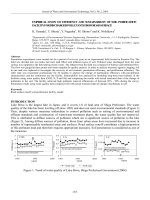
![Tài liệu Báo cáo khoa học: Specific targeting of a DNA-alkylating reagent to mitochondria Synthesis and characterization of [4-((11aS)-7-methoxy-1,2,3,11a-tetrahydro-5H-pyrrolo[2,1-c][1,4]benzodiazepin-5-on-8-oxy)butyl]-triphenylphosphonium iodide doc](https://media.store123doc.com/images/document/14/br/vp/medium_vpv1392870032.jpg)
